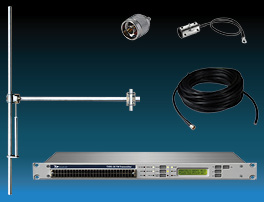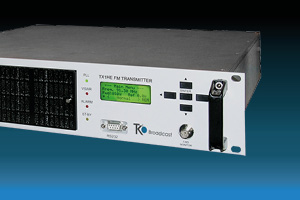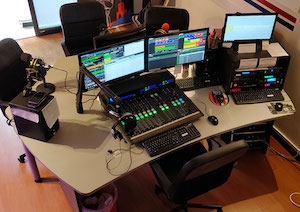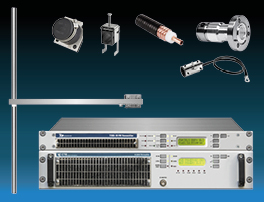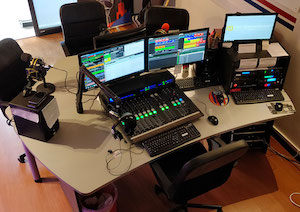Orban OPTIMOD 8700i
FM Digital Audio Processor

OPTIMOD 8700i FM+HD Digital + RDS/RBDS
OPTIMOD 8700i is Orban’s flagship broadcast audio processor for
both analog FM transmission and digital media (DAB+/HD
Radio/Streaming).
Providing 2-band as well as 5-band audio processing structures,
the 8700i gives you the industry’s
most consistent sound, track-to-track and source-to-source.
This consistency allows you to create a sonic signature for
your station with the assurance that your signature will stay locked in,
uniquely branding your sound.
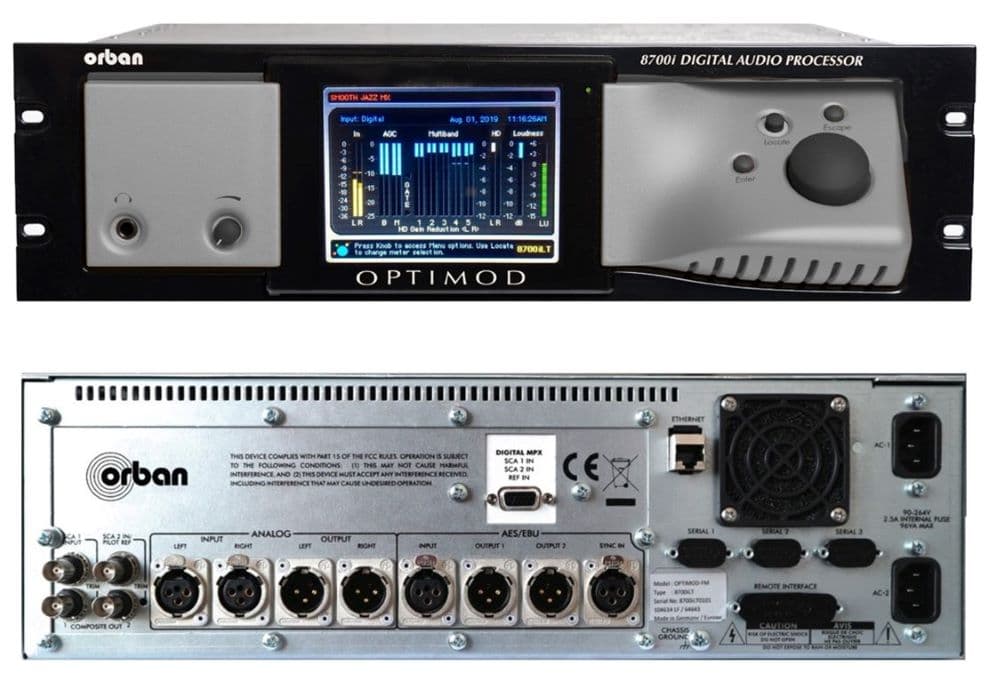
Overview
The OPTIMOD 8700i Audio Processor has exclusive features such
as Xponential Loudness™ which brings hyper-compressed
music back to life, revealing detail and increasing impact while
reducing listening fatigue and distortion.
With its Multipath Mitigator phase corrector multipath
distortion can be reduced without compromising the stereo separation and
thanks to the Subharmonic Synthesizer modern-sounding
bass punch can be added to older recordings.
It provides you with Orban’s MX limiter technology which
lowers distortion, improves transient punch, and minimizes
preemphasis-induced high
frequency loss.
Further outstanding features are the Dante interface which
provides dual-redundant AoIP with AES67
support, its digital MPX interface,
a built-in streaming server for monitoring purposes and
monitored and alarmed dual
redundant power supplies as well as safety bypass relays for carefree 24/7
operation.
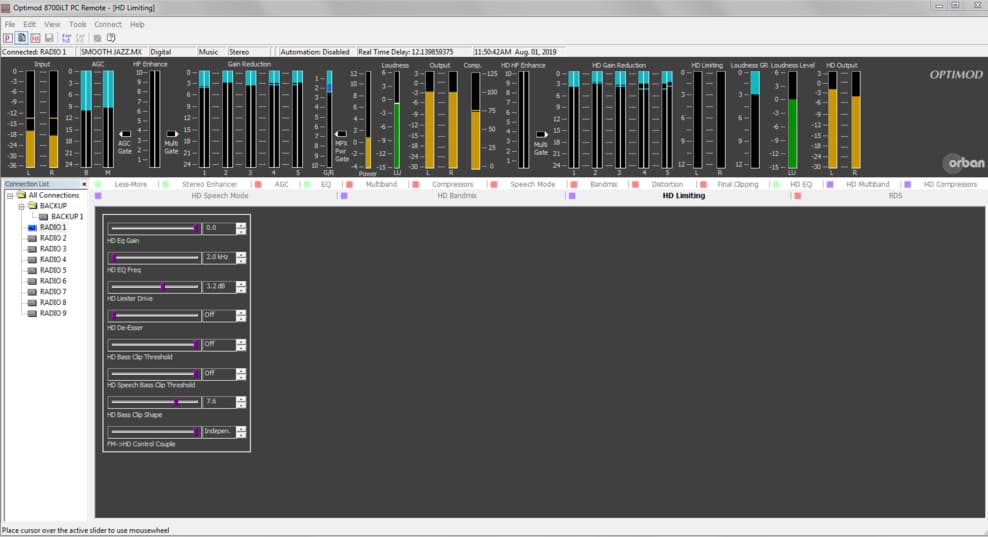
Key Features
Audio Processor Quick Setup
This features provides a guided, systematic procedure for setting up your 8700i Audio Processor.
Factory Presets & LESS-MORE Control
The OPTIMOD 8700i comes with a variety of factory presets which you can use as basis to create your own signature sound processing. Orban is happy to help you find the perfect setup for your station. Easy LESS-MORE adjustment of the dynamics processing lets anyone get excellent results, while audio processing experts can fine-tune to their exact preferences with Intermediate or Advanced Control.
Xponential Loudness™ Algorithm
The Xponential Loudness™ algorithm reduces listening fatigue and actually improves listeners’ hearing using adaptive psychoacoustics. It revives music that has been “hypercompressed” in mastering and/or passed through lossy compression, like MP3. It’s like an audio magnifying glass that brings out hidden detail, clarifying audio and inspiring audiences to listen longer.
Subharmonic Synthesizer
The Subharmonic Synthesizer creates energy one octave below program energy in the range of 50-90 Hz when such energy is not present at the input and when music is detected. It adds punch and slam to older material while retaining musicality.
“Multipath Mitigator” Left/Right Phase Skew Correction
Applied to both the analog and digital radio processing chains, the phase skew corrector minimizes L–R energy that can cause multipath distortion while preventing comb filtering in mono receivers and stereo receivers when they blend.
“True Peak” Control
”True Peak” Control is available for the digital radio processing with an accuracy of better than 0.5 dB. For typical program material, accuracy is 0.2 dB.
ITU BS-412 Multiplex Power Control
An improved BS-412 Multiplex Power Controller provides a new user-adjustable, program-adaptive algorithm to make operation smoother and more subtle.
ITU-R BS.1770-4 Loudness Control
Loudness Control is available for digital radio and analog radio processing chains in countries that enforce a BS.1770 loudness limit on digital and/or analog radio broadcasts.
Composite Limiter/Clipper
A patented “Half-Cosine Interpolation” composite limiter providing excellent spectral protection of the pilot tone and SCAs (including RDS). If you prefer the sound of conventional composite clipping, we also offer a defeatable composite clipper with spectral protection for the pilot tone and subcarriers. The composite clipper drives the composite limiter, which serves as an overshoot compensator for the composite clipper when it is active.
SSB Stereo Encoder Operation
Allows its stereo encoder’s stereo subchannel modulator to operate in an experimental compatible single sideband/vestigial sideband mode. In SSB mode, the sub-channel modulator acts as a pure SSB generator for L–R material in the frequency range of 150 Hz to 17 kHz and as a vestigial sideband generator below 150 Hz.
Low-Delay DJ Monitor Output
The MX limiter, Multipath Mitigator, and subharmonic synthesizer add delay that makes it impractical for talent to monitor all of the processing structures off-air with headphones. A new, dedicated headphone monitor chain (with about 6 ms delay) provides a full five-band FM processor that lets you dial in your preferred amount of “FM clipper sound.”
Streaming Monitor Output
Used with the 8700i’s remote control application, the streaming monitor facilitates checking or improving your station’s signature sound when you are unable to receive the 8700i processed FM signal off-air. The steaming feature allows you to monitor several points within 8700i. The MP3 and OPUS codecs and the Icecast2 and SHOUTcast2 streaming protocols are supported, allowing streaming directly to the client PC via your LAN or the Internet.
Dante™ Audio-Over-IP Connectivity
Dante provides a dual-redundant Ethernet connection for two stereo audio inputs and two stereo outputs, each with a dedicated level control. Sample rate conversion is provided for both the inputs and the outputs. Full AES67 compatibility is provided.
Digital MPX
The 384/192 kHz AES3 digital composite output that is compatible and interoperable with the 192 kHz standard being implemented by several transmitter manufacturers.
10 MHz/Wordclock Reference Input
10 MHz/Wordclock Reference Input: A reference input allows the internal DSP clock, the stereo pilot tone frequency and digital composite output sample rate to be locked to a 10 MHz or 1 x wordclock reference signal, facilitating single-frequency-network (SFN) and near-single-frequency-network (N-SFN) operation.
Safety Bypass Relays
Analog and AES3 digital inputs and outputs have hard-wire safety bypass relays in case of hardware or power failures.
Dual Power Supplies
The 8700i’s dual power supplies with independent AC line inputs provide redundant operation to ensuring maximum uptime. Both power supplies are monitored permanently and, in case of failure, an alarm is generated.
RDS
The 8700i Audio Processor has a built-in full-featured RDS/RBDS generator that supports static and dynamic RDS values.
Bypass Test Mode and Tone Generator
A Bypass Test Mode can be invoked locally, by remote control or by automation to perform a broadcast system test or to compare easily original and processed sound. A built-in line-up tone generator facilitates quick and accurate level setting.
SNMP Support
The SNMP (Simple Network Management Protocol) feature allows you to monitor your OPTIMOD’s status and to send alarm notifications via your OPTIMOD’s Ethernet connection to your network.
Remote Control or front panel operation
You can operate and configure the 8700i Audio Processor comfortably via the supplied Windows PC Software using your local network or the Internet. Alternatively all functionalities are also available via the front panel with its colored display.
Specifications
Frequency Response (Bypass Mode; Analog Processing Chain):
Follows standard 50µs or 75µs pre-emphasis curve ±0.10 dB, 2.0 Hz - 15 kHz. Analog left/right output and Digital output can be user configured for flat or pre-emphasized output.
Sample Rate:
64 kHz to 512 kHz, depending on processing being performed.
Noise:
Output noise floor will depend upon how much gain the processor is set for (Limit Drive, AGC Drive, Two-Band Drive, and/or Multiband Drive), gating level, equalization, noise reduction, etc. It is primarily governed by the dynamic range of the A/D converter, which has a specified overload-to–noise ratio of 110 dB. The dynamic range of the digital signal processing is 144 dB.
Total System Distortion (de-emphasized, 100% modulation):
<0.01% THD, 20 Hz - 1 kHz, rising to <0.05% at 15 kHz. <0.02% SMPTE IM Distortion.
Total System Separation:
> 55 dB, 20 Hz - 15 kHz; 65 dB typical.
Polarity (Two-Band and Bypass Modes):
Absolute polarity maintained. Positive-going signal on input will result in positive-going signal on output when HD Polarity and FM polarity controls are set to POSITIVE.
Peak Control at HD Output:
The peak limiter is oversampled at 256 kHz, yielding a worst- case overshoot of 0.5 dB at the analog output and for all output sample rates. (To achieve this performance at 32 kHz output sample rate, it is necessary to set the 8700i’s HD lowpass filter cutoff frequency to 15 kHz.)
Delay
Defeatable Analog FM Diversity delay:
0.27 to 12.0 seconds, adjustable in one-sample increments at 64 kHz sample rate to allow the delays of the analog and digital paths in the HD Radio system to be matched at the receiver output. The relative delay between the HD/digital radio and analog FM outputs stay constant regardless of the structure in operation. The delay can be changed via 8700i PC Remote software, via SNMP, and via Telnet-style (terminal control) commands through the serial and Ethernet ports. Several manufacturers make HD Radio monitors that can adjust the 8700i’s diversity delay via terminal control to compensate for changes in HD delay that might occur elsewhere in the transmission system. To avoid introducing artifacts in the analog FM path, its delay is held constant and HD delay is varied if the adjustment does not exceed ±1.3 seconds.
Minimum Processing Delay:
Processing structure dependent. Typically 17 ms for normal latency Five-band, 13 ms for low-latency Five-band, 3.7 ms for ultra-low-latency Five- band, and 17 or 22 ms for 2-band, depending on crossover structure chosen. MX presets have approximately 270 ms delay. The multipath mitigator adds 146 ms of additional delay, and can be bypassed in situations like outside broadcasts where talent needs to monitor off-air. The defeatable subharmonic synthesizer adds 67.5 ms of delay when active.
Headphone Monitor Processor Delay:
The low-delay, dedicated headphone monitor processor has 6 ms of delay and provides a complete FM processing chain, including 5-band compressor and distortion-cancelled FM clipper. The clipper drive is adjustable to allow dialing in the preferred amount of “FM clipper sound.”
Analog Audio Input
Configuration:
Stereo.
Impedance:
> 10kΩ load impedance, electronically balanced1.
Nominal Input Level:
Software adjustable from –4.0 to +13.0 dBu (VU).
Maximum Input Level:
+27 dBu.
Connectors:
Two XLR-type, female, EMI-suppressed. Pin 1 chassis ground, Pins 2 (+) and 3 electronically balanced, floating and symmetrical.
A/D Conversion:
24 bit 128x oversampled delta sigma converter with linear-phase anti- aliasing filter.
Filtering:
RFI filtered, with high-pass filter at 0.15 Hz.
Analog Audio Output
Configuration:
Stereo. The analog output can emit the analog FM processed signal, the digital radio processed signal, or the low-delay monitor signal. The FM processed signal can be flat or pre-emphasized (at 50µs or 75µs), software-selectable.
Source Impedance:
50Ω, electronically balanced and floating.
Load Impedance:
600Ω or greater, balanced or unbalanced. Termination not required or recommended.
Output Level (100% peak modulation):
Adjustable from –6 dBu to +24 dBu peak, into 600Ω or greater load, software-adjustable.
Signal-to-Noise:
> = 90 dB unweighted (Bypass mode, de-emphasized, 20 Hz - 15 kHz bandwidth, referenced to 100% modulation).
Crosstalk:
<= –70 dB, 20 Hz - 15 kHz.
Distortion:
<= 0.01% THD (Bypass mode, de-emphasized) 20 Hz - 15 kHz bandwidth.
Connectors:
Two XLR-type, male, EMI-suppressed. Pin 1 chassis ground, Pins 2 (+) and 3 electronically balanced, floating and symmetrical.
D/A Conversion:
24 bit 128x oversampled.
Filtering:
RFI filtered.
Hardwire Bypass:
Removing power from the Optimod will connect the left and right audio inputs to the left and right audio outputs via a relay.
Digital Audio Input
Configuration:
Stereo per AES3 standard, 24 bit resolution, software selection of stereo, mono from left, mono from right or mono from sum.
 BACK TO ON-AIR STUDIO
BACK TO ON-AIR STUDIO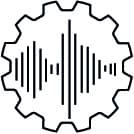 AUDIO INTERFACES
AUDIO INTERFACES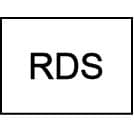 RDS ENCODER
RDS ENCODER STUDIO ACCESSORIES
STUDIO ACCESSORIES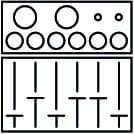 AUDIO MIXER
AUDIO MIXER